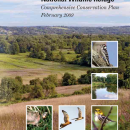What We Do
Wildlife conservation is at the heart of the National Wildlife Refuge System. It drives everything on U.S. Fish and Wildlife Service lands and waters managed within the Refuge System, from the purposes for which a national wildlife refuge national wildlife refuge
A national wildlife refuge is typically a contiguous area of land and water managed by the U.S. Fish and Wildlife Service for the conservation and, where appropriate, restoration of fish, wildlife and plant resources and their habitats for the benefit of present and future generations of Americans.
Learn more about national wildlife refuge is established to the recreational activities offered to the resource management tools used. Using conservation best practices, the Refuge System manages Service lands and waters to help ensure the survival of native wildlife species.
Management and Conservation
Comprehensive Conservation Plan (CCP)
The purpose of a comprehensive conservation plan (CCP) is to specify a management direction for the refuge for the next 15 years. The goals, objectives, and strategies for improving refuge conditions—including the types of habitat we will provide, partnership opportunities and management actions needed to achieve desired conditions – are described in the CCP found below.
Our Projects and Research
Habitat management at Wallkill River focuses largely on controlling natural succession, and manipulating water levels to provide waterbird habitat. In early spring, snow melt and rains yield high water levels in the Liberty Marsh impoundments, benefitting thousands of migratory waterfowl. As spring progresses, water levels are lowered to produce open mudflat habitat for shorebirds. Remaining pockets of water provide foraging areas for the great blue and green herons that nest on the refuge. By late summer, any remaining water is held for the fall waterfowl migration. In most years, seasonal rains raise the water level before winter’s freeze sets in.
Natural succession threatens habitats that are considered “early successional”. Without management, these areas would revert to forest and be lost to species depending on them for nesting and foraging habitat. Grassland management is facilitated by a cooperative program in which local farmers hay the fields after the nesting season. Farmers benefit from the use of hay, and the refuge benefits from assistance in keeping the fields open. In other areas, biologists wish to maintain old fields in scrubby, shrub habitats desirable for a different suite of breeding birds, raptors and pollinators. These fields are cut every 3-5 years to prevent the establishment of trees.
Law Enforcement
Protecting resources and people on our refuges is the fundamental responsibility of refuge officers. The mission of the Refuge Law Enforcement Program is to support the administration of the National Wildlife Refuge System through the management and protection of natural, historic and cultural resources, property, and people on lands and waters of our national wildlife refuges.
Laws and Regulations
Unlike national parks, state parks, and state forests, the management priority at national wildlife refuges is "Wildlife First." These lands are managed by the U.S. Fish and Wildlife Service, which is the only agency of the U.S. Government whose primary responsibility is fish, wildlife, and plant conservation. Public uses of national wildlife refuges must be compatible with plant and animal conservation. Our guiding legislation identifies priority public uses on national wildlife refuges that can be allowed if they are compatible with the management of that refuge for wildlife.


